In today’s digital landscape, email marketing remains a cornerstone of effective customer engagement and business growth. As businesses seek to optimize their marketing strategies, the choice between email marketing platforms becomes crucial. Two popular contenders in this arena are ConvertKit and Drip, each offering unique features and capabilities to cater to different business needs. Additionally, emerging solutions like Prism Reach are pushing the boundaries of personalization and AI-driven marketing. This article delves into a comprehensive comparison of ConvertKit and Drip, exploring their strengths, weaknesses, and suitability for various business types, while also highlighting innovative alternatives that can elevate your email marketing efforts.
Key Facts
- ConvertKit: Known for its user-friendly interface, making it ideal for bloggers, content creators, and small businesses.
- Drip: Offers advanced automation and e-commerce integrations, making it suitable for larger businesses with complex marketing needs.
- Prism Reach: An AI-powered SaaS solution that enhances email marketing through deep personalization and automated content curation.
- Automation: Drip provides more sophisticated automation capabilities compared to ConvertKit.
- Pricing: ConvertKit starts at $25/month for up to 1,000 subscribers, while Drip starts at $39/month for up to 2,500 subscribers.
ConvertKit vs Drip: Features and Functionalities
1. Ease of Use
ConvertKit prides itself on its user-friendly interface, making it accessible to beginners and non-technical users. As noted by WinSavvy, “ConvertKit is known for its user-friendly interface, making it suitable for beginners and those without technical expertise.” This simplicity is particularly appealing to bloggers and small business owners who want to focus on content creation rather than navigating complex software.
Drip, on the other hand, offers more advanced features but comes with a steeper learning curve. According to Comparlify, “While powerful, it has a steeper learning curve compared to ConvertKit.” This complexity is justified by its sophisticated automation capabilities, which are particularly valuable for businesses with intricate marketing needs.
Hidden Gem: Utilize Conditional Content in Emails
Both ConvertKit and Drip allow you to send conditional content based on subscriber tags. This means you can personalize emails for different segments without creating multiple versions of the same email. For example, you can include specific offers or messages tailored to different groups within your audience, enhancing engagement and relevance.
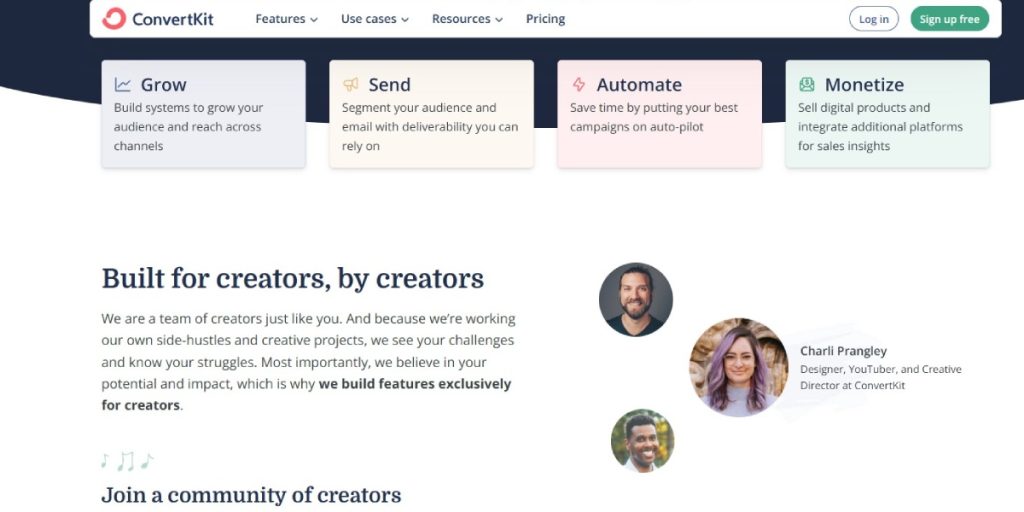
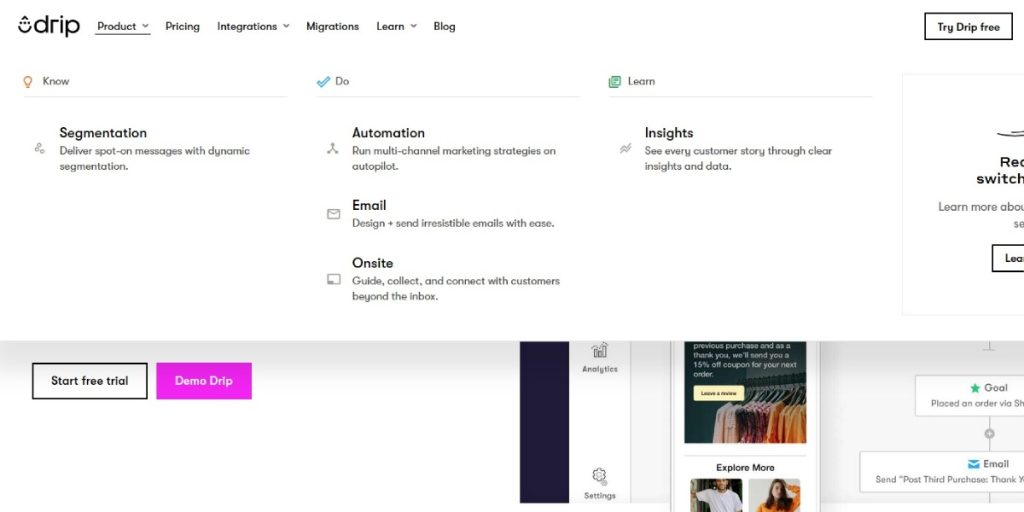
2. Automation Capabilities
Both platforms offer robust automation tools, but they differ in complexity and flexibility. ConvertKit provides straightforward and effective automation tools, including a drag-and-drop workflow builder. As stated on the ConvertKit website, “Visual Automations: Easy to create and manage visual automations and sequences.”
Drip takes automation a step further with its advanced capabilities. Marketing Auto Finder highlights that Drip is “Known for its sophisticated and complex automation capabilities, ideal for businesses needing in-depth customization.” This includes a visual workflow builder that allows for creating intricate automation sequences, making it suitable for businesses with complex marketing strategies.
Hidden Gems:
Use Visual Automation Workflows in Drip: Drip’s visual automation builder allows for complex workflows that can respond to user behavior across multiple channels. By mapping out customer journeys visually, you can create highly personalized experiences that adapt based on user actions, leading to better retention and sales.
Implement Tag-Based Automation in ConvertKit: ConvertKit allows you to automatically tag subscribers based on their interactions, such as clicking a link. This feature can be used to trigger follow-up emails or specific sequences tailored to their interests, making your communication more targeted and effective.
Use Drip’s Lead Scoring Feature: Drip includes a lead scoring system that allows you to prioritize leads based on their engagement levels. By assigning scores to actions like email opens, clicks, and website visits, you can focus your efforts on high-value leads, improving conversion rates.
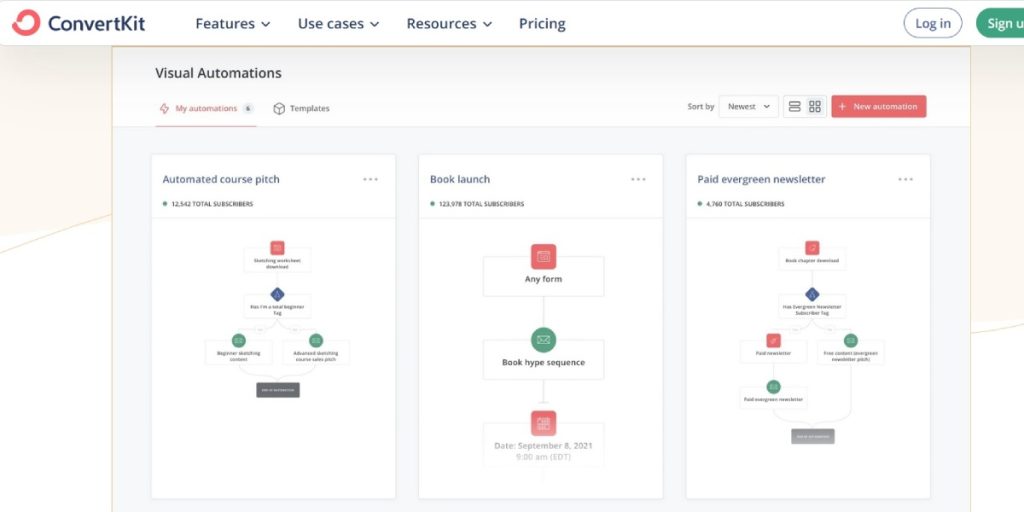
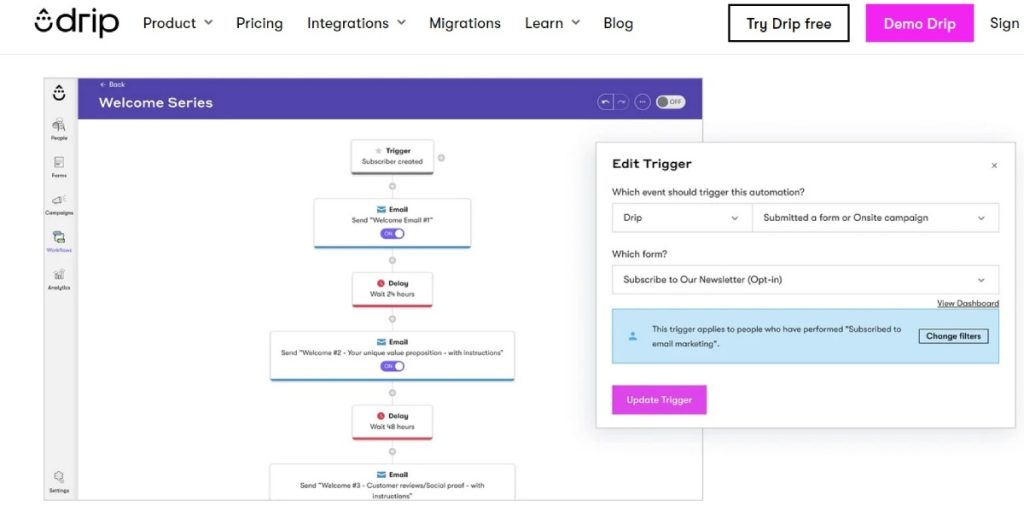
3. E-commerce Integration
For businesses heavily focused on e-commerce, Drip has a clear advantage. Marketing Auto Finder notes, “Extensive integrations with e-commerce platforms like Shopify, BigCommerce, and WooCommerce.” This makes Drip an excellent choice for online retailers looking to leverage email marketing for sales growth.
ConvertKit, while capable of integrating with e-commerce platforms, has more limited options in this area. According to Marketing Auto Finder, ConvertKit offers “Limited direct integrations with e-commerce platforms.”
Hidden Gem: Utilize Landing Pages for Lead Generation in ConvertKit
ConvertKit provides customizable landing pages that can be used for lead generation without needing additional tools. Create targeted landing pages for specific campaigns or products to capture leads effectively and direct them into relevant email sequences.
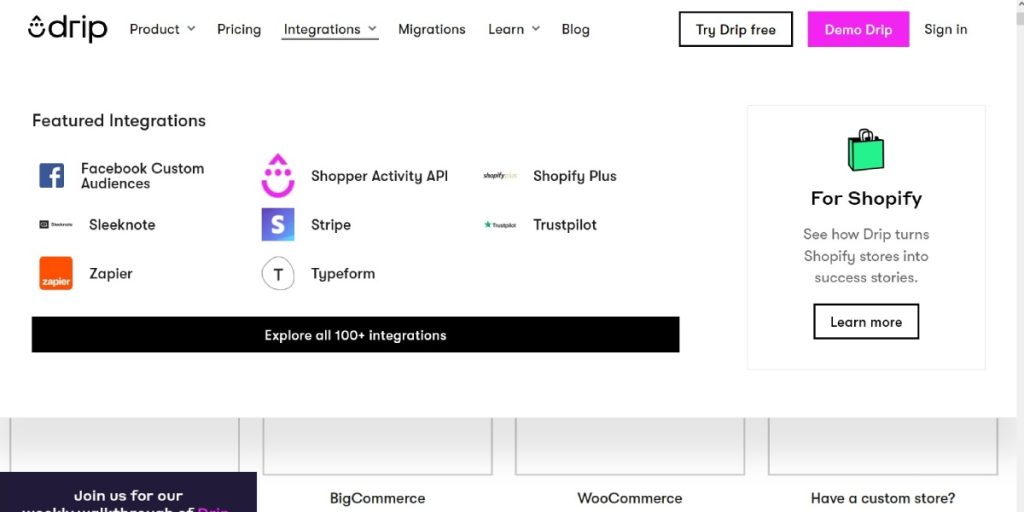
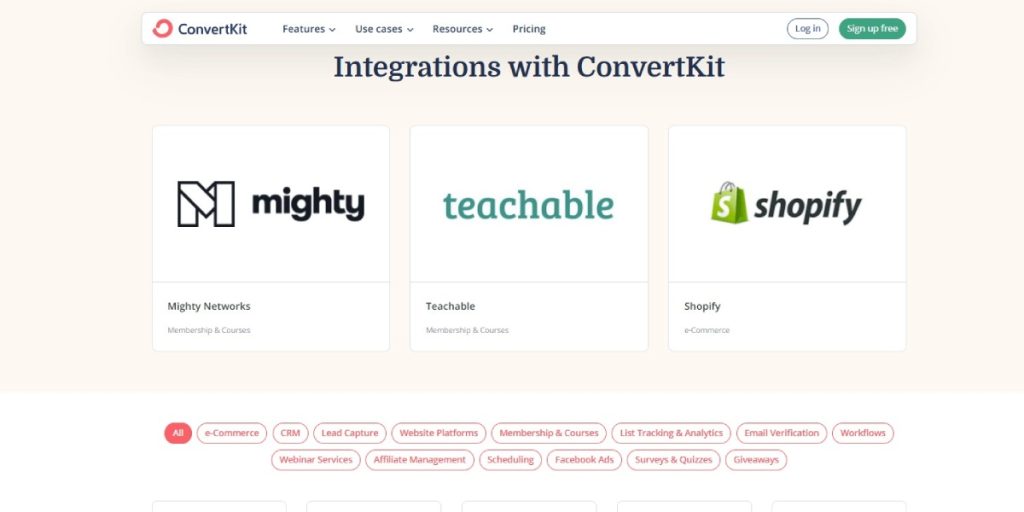
4. Segmentation and Personalization
Both platforms offer segmentation capabilities, but Drip provides more advanced options. Drip uses tags, actions, and custom fields for detailed segmentation, allowing for highly targeted campaigns. As stated by Marketing Auto Finder, Drip offers “Advanced segmentation capabilities using tags, actions, and custom fields.”
ConvertKit also uses tags for segmentation, enabling targeted email campaigns based on specific interests and actions. However, its capabilities are not as extensive as Drip’s.
Hidden Gem: Personalize Emails with Custom Fields
Both platforms support custom fields, but many users underutilize this feature. Use custom fields to gather specific information about your subscribers, such as their interests or purchase history, and personalize your emails accordingly. This level of personalization can significantly increase open and click rates.
5. Pricing
ConvertKit starts at $25/month for up to 1,000 subscribers, with a free plan available for smaller lists. Drip’s pricing begins at $39/month for up to 2,500 subscribers. Both offer a 14-day free trial. As your subscriber list grows, ConvertKit can become more expensive, which is a consideration for rapidly growing businesses.
Hidden Gem: Conduct A/B Testing on Subject Lines and Content
Both platforms offer A/B testing features; however, many users do not fully utilize them. Regularly test different subject lines, content formats, and calls-to-action to find what resonates best with your audience. This iterative approach can lead to significant improvements in engagement metrics over time.
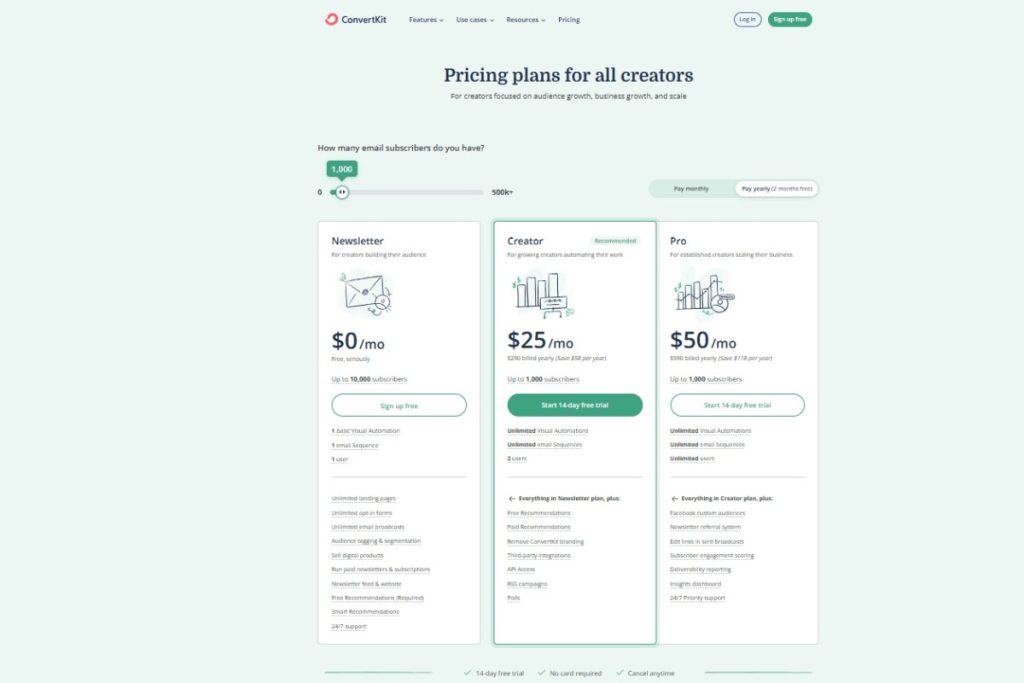
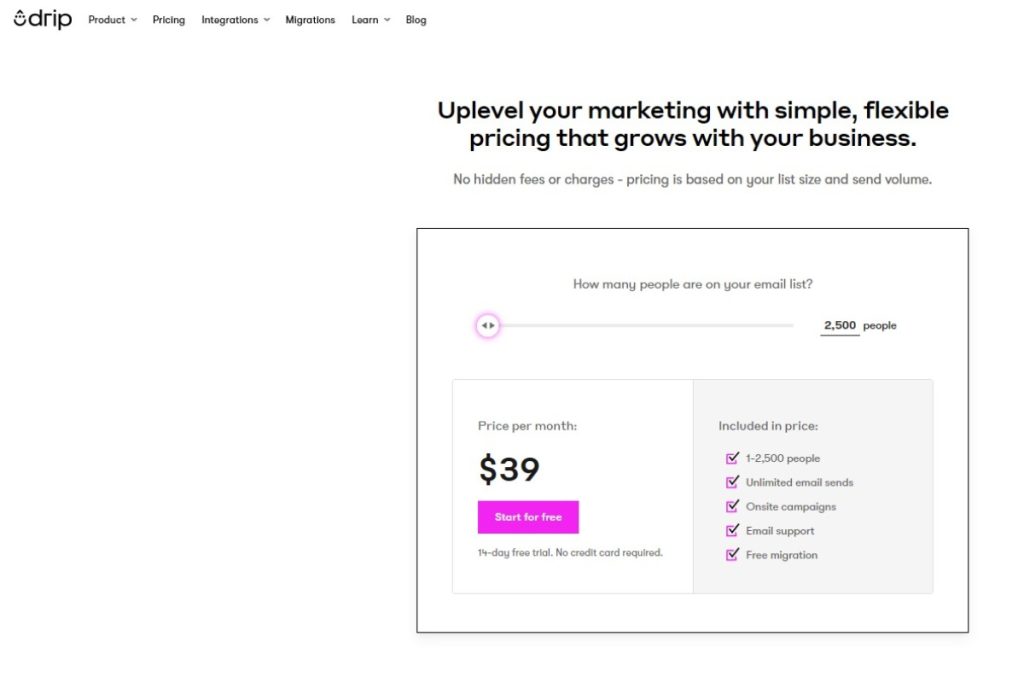
6. Reporting and Analytics
Drip offers more comprehensive reporting focused on consumer behavior and email performance. Website Planet notes that Drip provides “Comprehensive reports focused on consumer behavior and email performance.”
ConvertKit also provides detailed reports on email performance, including deliverability, open rates, click rates, and conversions, but they are less extensive than Drip’s offerings.
Hidden Gem: Automate Feedback Requests After Purchases
Set up automated emails in both platforms to request feedback from customers after they make a purchase or complete an important action, such as attending a webinar. This not only helps gather valuable insights but also keeps your brand top-of-mind for future interactions.
Innovative Solutions by Prism Reach
While ConvertKit and Drip offer robust email marketing solutions, Prism Reach introduces a groundbreaking approach to newsletter personalization. Leveraging advanced AI technology, Prism Reach creates hyper-personalized newsletters tailored to individual subscriber interests, setting a new standard for engagement and effectiveness in email marketing.
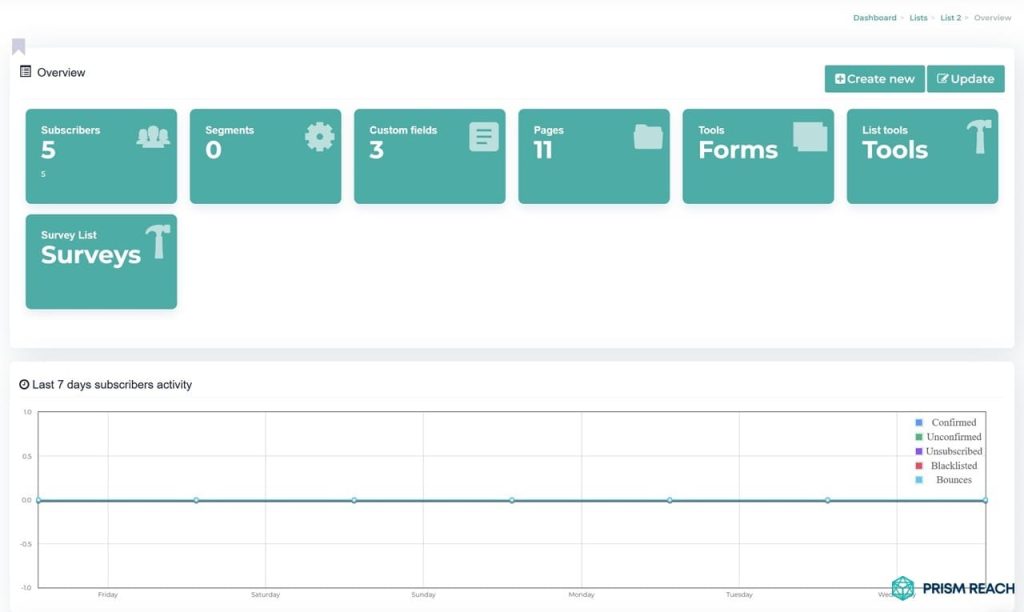
Key Benefits of Prism Reach
AI-Powered Personalization:
Prism Reach utilizes sophisticated AI algorithms to analyze subscriber behavior and preferences in real-time. This enables the platform to customize every aspect of newsletters, from content selection to layout, ensuring that each email resonates with the recipient.
- Content Clustering: Prism Reach’s proprietary AI models categorize content from various sources, such as website content and social media posts, into relevant categories. This ensures that only the most pertinent information is delivered to each subscriber.
- User Avatars: The platform creates detailed user avatars by analyzing a variety of data points, including location, engagement history, and predicted interests. This deep understanding of each subscriber allows for highly targeted marketing strategies that align with individual preferences.
- Personalized Introductions: Prism Reach generates custom introduction paragraphs for each subscriber, adding a personal touch that enhances the overall engagement of the newsletter.
Seamless Setup and Integration:
Prism Reach is designed for ease of use, allowing marketers to set up their campaigns within minutes.
- Quick Setup: The platform can be integrated within 10 minutes, making it user-friendly and accessible to marketers who need to implement effective email strategies swiftly.
- One-Click Uploads: Facilitates easy migration of existing subscriber lists, ensuring a smooth transition from other platforms without the hassle of manual data entry.
- AI-Enhanced Sign-Up Forms: Prism Reach’s sign-up forms are designed to increase conversion rates by using AI-generated content tailored to the user’s context. Additionally, these forms are optimized for GDPR compliance, ensuring data privacy and security.
Advanced AI Features:
Prism Reach incorporates a range of advanced AI features that enhance the effectiveness of email marketing campaigns.
- Anti-Spam Checks: The platform includes built-in anti-spam mechanisms that ensure high deliverability rates, keeping emails out of spam folders and increasing the likelihood of reaching the intended audience.
- Predictive Analytics for Optimal Sending Times: Prism Reach uses predictive analytics to determine the best times to send newsletters, maximizing open rates and engagement by reaching subscribers when they are most receptive.
- AI Feedback Loop: An ongoing AI feedback loop continuously monitors subscriber interactions and feedback, refining content delivery and campaign performance to ensure sustained optimization over time.
Unlike ConvertKit and Drip, Prism Reach automates the entire process of content curation and newsletter creation, saving time and resources while delivering highly relevant content to each subscriber. Its AI feedback loop continuously refines the user experience, ensuring ongoing optimization of content delivery and campaign performance.
Moreover, Prism Reach offers seamless monetization options, allowing publishers to effortlessly generate revenue through targeted advertising and premium sponsorship opportunities. This feature sets it apart from traditional email marketing platforms, providing a comprehensive solution for content distribution and monetization.
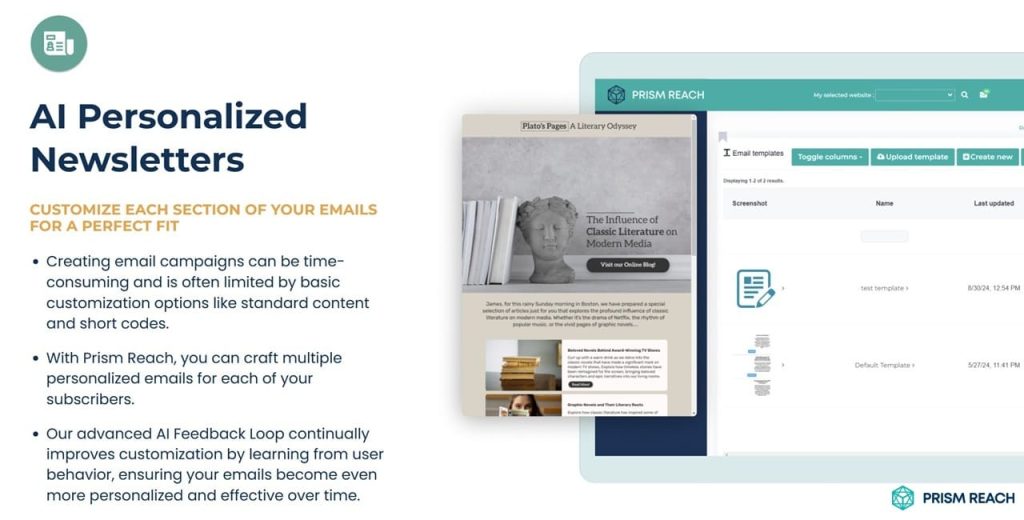

Automated Content Curation and Creation
Unlike ConvertKit and Drip, Prism Reach automates the entire process of content curation and newsletter creation. The platform’s AI scans and categorizes content from multiple sources, selecting the most relevant pieces for each subscriber based on their unique profiles. This automation not only saves time and resources but also ensures that each newsletter is packed with content that truly matters to the individual reader.
Prism Reach’s AI also generates personalized introduction paragraphs, making each newsletter feel uniquely crafted for the recipient. This level of personalization goes beyond traditional segmentation, creating a more intimate and engaging experience for subscribers.
Monetization Options
Prism Reach offers seamless monetization features, allowing publishers to effortlessly generate revenue through targeted advertising and premium sponsorship opportunities. By leveraging detailed subscriber data, the platform ensures that ads are relevant and engaging, enhancing both user experience and revenue potential.
- Targeted Advertising: Prism Reach’s AI-driven targeting ensures that ads are placed in front of the right audience segments, increasing the effectiveness of advertising campaigns and maximizing return on investment.
- Premium Sponsorships: Publishers can offer premium sponsorship opportunities to brands looking to reach their highly engaged subscriber base, providing an additional revenue stream without compromising the quality of content delivered to subscribers.
Comprehensive Solution for Content Distribution and Monetization
Prism Reach’s comprehensive approach to email marketing goes beyond mere automation. It provides a holistic solution that integrates content curation, personalized delivery, and monetization into a single platform. This all-in-one approach simplifies the process of managing email campaigns, allowing publishers and marketers to focus on creating valuable content and growing their audience.
Real-World Impact:
Publishers using Prism Reach have reported up to a 40% increase in engagement rates, attributing this success to the platform’s ability to deliver highly personalized content that resonates with their audience. Additionally, businesses leveraging Prism Reach have seen significant improvements in revenue generation through targeted advertising and optimized content delivery strategies.

Use Cases
- Publishers and Content Creators: Enhance reader engagement by delivering content that aligns precisely with each subscriber’s interests, leading to higher retention rates and increased readership.
- E-commerce Businesses: Utilize AI-driven personalization to showcase products that individual customers are most likely to purchase, boosting sales and customer satisfaction.
- Media Outlets: Streamline the process of content distribution, ensuring that each newsletter is packed with relevant articles, news, and updates tailored to the diverse preferences of their audience.
Future Prospects
Prism Reach is committed to continuous improvement of its AI algorithms, ensuring that its solutions remain at the cutting edge of technology and marketing innovation. Looking ahead, the company aims to expand its technology into the eCommerce sector and explore new ways to leverage AI for broader marketing applications. This commitment to innovation ensures that Prism Reach will continue to offer valuable and forward-thinking solutions to its users.
Upgrade Your Email Marketing with AI Personalization!
FAQ
Conclusion
Both ConvertKit and Drip offer valuable features for email marketing, catering to different business needs and levels of expertise. ConvertKit shines in its simplicity and user-friendliness, making it an excellent choice for bloggers, content creators, and small businesses looking for an easy-to-use platform. Drip, with its advanced automation and e-commerce capabilities, is better suited for larger businesses or those with complex marketing needs, particularly in the e-commerce sector.
However, for businesses seeking cutting-edge personalization and AI-driven solutions, Prism Reach presents an innovative alternative. Its hyper-personalization capabilities and automated content curation offer a unique approach to newsletter marketing, potentially leading to higher engagement and revenue generation.
Ultimately, the choice between these platforms depends on your specific business needs, technical expertise, and growth plans. Consider your priorities in terms of ease of use, automation complexity, e-commerce integration, and personalization capabilities when making your decision.
Citations
- ConvertKit. (n.d.). Features. Retrieved from https://convertkit.com/features
- Drip. (n.d.). Features. Retrieved from https://www.drip.com/features
- Website Planet. (n.d.). ConvertKit vs Drip: Read My Advice Before You Sign Up [2024]. Retrieved from https://www.websiteplanet.com/blog/convertkit-vs-drip/
- WinSavvy. (n.d.). ConvertKit vs Drip: The Best Email Marketing Tool for 2024. Retrieved from https://www.winsavvy.com/convertkit-vs-drip-best-email-marketing-tool/
- Comparlify. (n.d.). ConvertKit vs Drip: Which Email Marketing Platform is Right for You? – Comparlify. Retrieved from https://comparlify.com/convertkit-vs-drip/